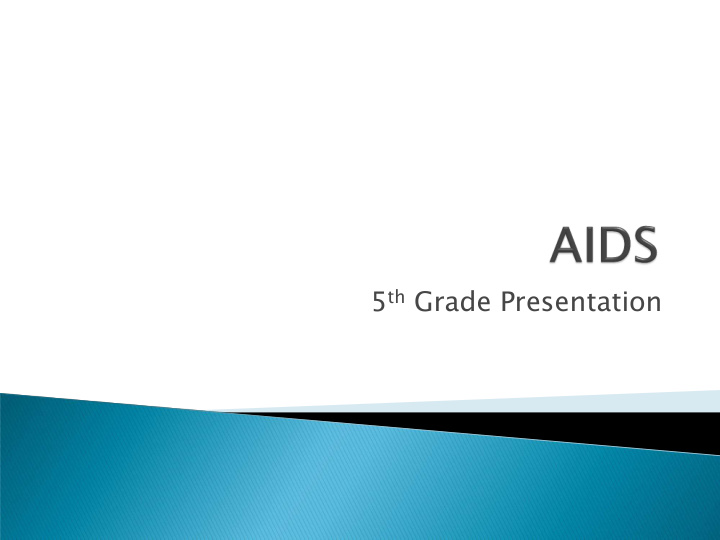



5 th Grade Presentation
The Pennsylvania Board of Education has mandated that schools offer instruction as part of the on- going health curriculum during their education. As per state guidelines, any student may be excused from instruction about HIV if a written request is furnished by the student’s parent/guardian. A letter with dates of instruction will be posted on the building webpage prior to the start of the classes. Dates will also be on the nurse’s calendar.
Introduction to terminology and the immune system Phases of HIV infection and transmission of the virus Sources for accurate information and statistics Post test
Acquired Something you get that you didn’t always have Immune To be protected from injury or illness Deficiency Not enough Syndrome Disease, illness, or condition
A disease caused by a virus which the immune system is unable to fight
Human Immunodeficiency Virus
Skin Respiratory System Gastrointestinal system Immune System – system affected by the HIV
Stages of the Chicken Pox Virus Fever 1. Headache 2. Spots 3. Blisters 4. Scabbing 5.
An infected person is able to transmit the virus during all phases of the illness and is thought to remain infected for life.
Period after infection Before blood test becomes positive May have self limiting brief illness Once infected, may be infectious to others in a matter of days. Virus rapidly reproduces
Remain symptom free for 6 months to average time of 11 years Person looks and feels well May have some immune abnormalities HIV test becomes positive – presence of antibody
Last for months or years before a diagnosis of AIDS Variety of symptoms – prolonged fever, swollen glands, weight loss, fatigue Immune system growing weaker Develop secondary infections
Immune system badly damaged Can’t fight off other infections T cells < 200 Opportunistic Infections take over
Blood Transmission IV drug users that share needles Other kinds of needle sharing activities such as tattooing, body piercing Pregnant woman to her unborn child Having sex with someone who is infected with HIV
Casual contact Swimming pools, insect stings, drinking fountains Fluids that do not transmit HIV - sweat, urine, saliva, tears Universal precautions Blood donation/ transfusion
People can get HIV infection by being in the same 1. room with a person with AIDS. There is a vaccine to prevent HIV Infection. 2. HIV infection is transmitted by sneezing and 3. coughing. A person can get HIV infection by donating blood. 4. The Human Immunodeficiency virus can be 5. transmitted by having sex with an infected individual.
People can look and feel healthy and still transmit 6. the HIV. People who inject drugs and share the needles 7. are high risk for acquiring the AIDS virus. An infected mother can transmit HIV to her 8. unborn child. People can get the HIV from sharing a soda. 9. Men cannot transmit the AIDS virus 10. Handwashing is one of the worst ways of 11. preventing any illness from being transmitted from one person to another.
Parents Grandparents Teachers Friends Doctors and Nurses
The Center for Disease Control Pennsylvania Department of Health Allegheny County Health Department
People living with HIV/AIDS worldwide – 34 million People living with HIV/AIDS in the US – 1.6 million People newly infected with HIV worldwide – 2.7 million AIDS deaths since first discovered – 28 million AIDS deaths 2010- 1.8 million
Ev Ever ery y 9 9 ½ minutes utes someon eone e is infected ected with h HIV An estima imated ted 40 40,60 600 b 0 beco come me infected cted each ch year More than n 1 1 million lion peopl ple e are living ing with h HIV Of Of these se 1 1 milli lion, on, 20 20% do not know ow that t they y are infected ected Despite ite new therapi apies, es, people le with h HIV V still l develop elop AIDS More than n 1 1 million lion peopl ple e have ve been diagnose gnosed d with h AIDS More than n 14 14,00 000 p 0 people le die each ch year
Cumulative cases AIDS 2864 Cumulative deaths from AIDS 1539 Deaths in 2010 4 Allegheny County population 1.22 million
Pennsylvania is ranked 7 th in the number of AIDS cases reported The top 3 states are California, New York and Florida The lowest states are Vermont, South Dakota and Wyoming
Ongoing worldwide Medical treatment helping HIV+ persons to stay alive longer Drug Therapy – mixture of medications Prevention is based on education
At the present time…. There is no known cure for HIV infection There is no vaccine to protect against the HIV infection
Say “NO” to drugs Always practice Healthy Habits Abstain from sex Keep informed as new information is available
1. Acquired Immune Deficiency Syndrome is a disease for which there is presently no known cure 2. The HIV attacks the immune system of the body that usually fights off disease 3. HIV infection can be transmitted by a cough or a handshake. 4. A mother with HIV infection can infect her unborn child. 5. Drug users that share needles can get the HIV infection.
The HIV is transmitted through the blood of an 6. infected person. Some of the chronic symptoms of HIV disease are long 7. term fatigue, fever, swollen glands, and weight loss. Once a person becomes infected with the HIV virus, he 8. or she may have no symptoms but is still infectious. Most people have acquired the HIV from having sex 9. with someone who is infected. AIDS is a dangerous disease that only adult men can 10. get.
Recommend
More recommend